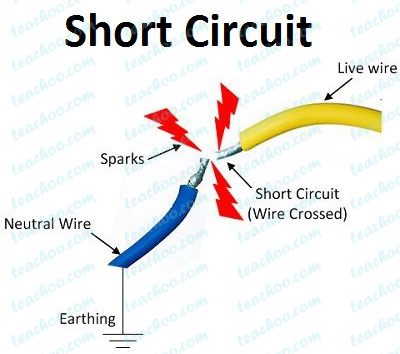Domestic Electric Circuit – Diagram, Wires, Fuse – Class 10 Physics
Let’s study how the electric circuit looks like in our homes
- First, Electric Power is Generated by Electric Power Stations
-
They supply Electricity to Our Homes through
Electric Poles
or
Underground Cables -
Electric Wires Reach our home through Main Supply.
They are of two types
Live Wire
– It is of red color insulation. It is called live wire (or positive)
Neutral Wire
– It is of black color insulation. It is called neutral wire (or negative)
Note
: Potential Difference between Live and Neutral wires is 220 Volts -
These wires pass into electricity meter through a Main Fuse or an MCB
-
From Main switch, they are connected to lines wire in the house
-
These wires supply electricity to different circuits
This how a Domestic Electric Circuit, i.e. a circuit in our homes looks like

Normally 2 circuits are used
-
15 Amperes Current Rating Circuit
These are used for appliances having higher load like electric iron, geyser -
5 Amperes Current Rating Circuit
These are used for appliances having less load like Tubelight, TV etc
Mục Lục
Different Sockets in a Switch
There are normally 3 sockets in a switch
These are for connecting 3 wires
-
Live Wire
– It is of red color -
Neutral Wire
– It is of black color -
Earth Wire
– It is of green color
What is Earth Wire? Why it is used?
Earth wire is a third type of wire in our electric circuit, it doesn’t carry any electricity,
One end of earth wire is buried in the earth and other end is connected to the metal casing of electrical appliances by using three pin plug.
If by chance, live wire touches any metal case parts of appliances then current passes directly to earth.
Hence, earth wire is used to prevent people from getting electric shocks
This wire has green color insulation
What is Overloading?

If too many electrical appliances are used simultaneously (together)
Or too many electrical appliances are connected to the same socket
they draw extremely large current from circuit
Due to this, the wires may get overheated and fire may start
This is called overloading
What is Short Circuit?

When live wire and neutral wire comes in direct contact with each other
they cause short circuit
This happens if insulation of both wires get torned
Current flows through wire without much resistance
Due to high current passing through wire,wire may get heated up and may catch fire
How to Prevent Short Circuit?
It is prevented by using fuse
What is Fuse? Why it is used?
A fuse is a device which is used in a circuit
to prevent damage to the appliances and the circuit due to overloading.
It stops the flow of unduly high electric current.

Nowadays, MCB (Miniature Circuit Board) is used in place of fuse
---teachoo.png)
If current becomes too large, MCB puts off a switch breaking off power supply
These can be switched on again and reused
Difference between MCB and Fuse
Fuse
MCB
It is a older technology
It is a new technology
it cannot be reused
This can be reused
It is now not used
It is used in homes
It works on principle of heating effect of electric current
It works on principle of Magnetic effect of electric current
Questions
NCERT Question 5 –
At the time of short circuit, the current in the circuit
- reduces substantially.
- does not change.
- increases heavily.
- vary continuously.
View Answer
NCERT Question 6 (d) –
State whether the following statements are true or false.
A wire with a green insulation is usually the live wire of an electric supply.
View Answer
NCERT Question 17 –
When does an electric short circuit occur?
View Answer
NCERT Question 18 –
What is the function of an earth wire? Why is it necessary to earth metallic appliances?
View Answer
This video provides a good understanding of how Domestic electric circuit works
Get live Maths 1-on-1 Classs – Class 6 to 12
Book 30 minute class for ₹ 499 ₹ 299















![Toni Kroos là ai? [ sự thật về tiểu sử đầy đủ Toni Kroos ]](https://evbn.org/wp-content/uploads/New-Project-6635-1671934592.jpg)


